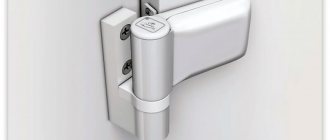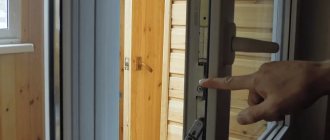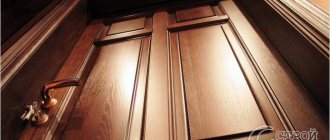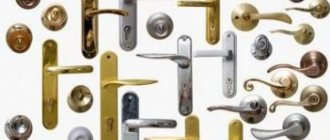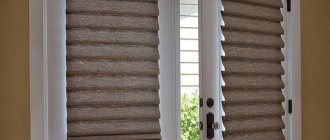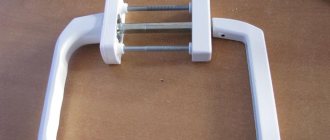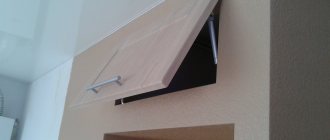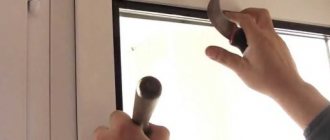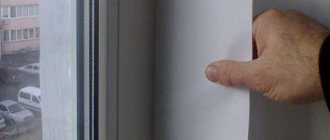Taking into account today's requirements for saving thermal energy in various buildings and structures, the use of plastic windows and doors is becoming very popular. It has been proven that heat loss due to leaky or ineffective windows and doors can be as high as 30%, which is very high.
Balcony doors have a rather complex design with the ability to adjust the closing density, ease of movement, and switch to different operating modes. Before making any adjustments, it is recommended to study the structure and purpose of each element and unit.
How to adjust a plastic balcony door
How to troubleshoot problems yourself:
Sagging of the canvas on the threshold
We begin the adjustment from the top hinge; to do this, the door must be opened. At the very top of the hinge there is a hex or asterisk screw (different models vary). We select a suitable key and make several turns with the key clockwise. There is no need to overdo it, it is better to tighten it once again after checking.
We close the door and see if we have fixed the problem or not.
If after the work done the sash touches the threshold, then you need to look at the lower hinge. If there is a protective cap on the loop, it must be removed. We are looking for the same hexagon or asterisk, it will also be located at the top of the loop. We make several turns with the key clockwise. We check, this procedure should solve the problem completely.
The leaf touches the door frame in the middle
This nuance can be solved by tightening the bolt on the canopy. We start everything from the bottom canopy, only this time we look for the bolt on the side. We select the key and make several turns back clockwise. This procedure will pull the canvas towards the canopy and automatically move it away from the free edge of the box.
The door creaks
PVC plastic balcony doors creak for three reasons:
- Adjustment of canopies and clamping is necessary;
- metal fittings are rusty;
- lack of lubrication.
Instructions for adjusting the door are shown in the instructions above.
Let's look at lubrication and corrosion control methods.
A universal and effective means of combating corrosion is a product called WD-40. Available in different capacities in the form of an aerosol can.
Inject WD-40 into the mechanism precisely and wait half an hour. Usually this time is enough for the product to eat away the rust. Next, use a rag or sponge to remove all dirt and apply lubricant precisely.
What you need for work
The set of tools and devices is small; for independent debugging of the system the following equipment will be sufficient:
- Small building level.
They check the adjustment of the balcony door. Plastic door adjustment diagram - Hexagon. Typically, all metal-plastic systems are adjusted with a 6 mm hexagon. Less commonly, you come across models with keys that have a sprocket slot for adjustment.
- A regular Phillips or flathead screwdriver.
- Pliers. Some of the eccentrics are adjusted with pliers.
Also, if problems arise with the seal or glazing beads, you will need a glue gun and a plaster spatula.
Return to contents
Vertical adjustment
Doors with a tilt-and-turn system have a rather complex design. But they are easy to adjust. To ensure the correct vertical position of the door leaf, you need to operate the corresponding adjusting screws, which allow you to lower or raise the structure.
The procedure for adjusting a plastic door, entrance or balcony:
- Identify the cause of the problem and prepare tools (hexagon or special star wrench). It is important that the hinges have a consistent appearance, otherwise making adjustments will be problematic, if not impossible.
Hexagonal star key Source prom.st
Adjustment features
For the adjustment procedure to be successful, the basic rule must be observed: balance. If you twist one eccentric, the problem will appear in another place. The success of the business is ensured if the person clearly identifies the reason for the incorrect work. The main point is to identify the place of friction, sagging, and imbalance of the door structure. Basic moments:
- First, the loop that requires adjustment is adjusted after a visual check;
- Do not turn the eccentric more than twice. If there are not enough of them, then this means that there is an additional problem elsewhere;
- If the door swings open in two positions at once, most likely the structure has shifted. The closing regulator, which is located at the bottom end on the handle side, can correct the situation. This element is a door angle lock in tilt mode;
- The problem of the response part is also solvable. For proper operation of the mechanism, it should be located in the frame. The door to the balcony will fit tightly to the post after the lower hinge is adjusted. If it does not close with one turn of the screw, then it is worth repeating the procedure;
- The subsidence will be corrected by working on the mechanism, which is located on the “scissors”. Most likely, the fasteners do not reach the mating part. Because of this, the angle is not fixed. To solve the breakdown, the door is lifted in the open state.
Periodically checking the door settings will avoid subsequent dismantling and repairs.
Door profile repair: scratches, chips
Some external defects may appear on the surface of the structure, such as chips, scratches, cracks or abrasions. If you want your overall interior to look beautiful, then you need to take appropriate measures to eliminate the minor damages described above.
This cosmetic repair involves the use of special glue, which covers all defects. When the glue dries, it is necessary to treat the damaged profile with fine sandpaper until the surface becomes even and smooth. After this, we wipe the treated areas with a solvent designed specifically for plastic. If the door is laminated, then the marks left from the repair work can be tinted using a construction marker; if without lamination, then you can simply paint it.
When adjustment of a plastic balcony door is required
The price of a plastic balcony door is quite high, but buying an expensive high-quality model does not save you from frequent cases of mechanism breakdowns. It's all about its frequent use, which leads to a decrease in the tightness of the sash.
In addition, double glazing provides excellent sound insulation, and PVC guarantees durability. However, it is these materials that noticeably make the structure heavier, as a result of which it begins to sag under its own weight and ceases to close tightly. As a result, a noticeable draft appears in the room, and insulating the balcony does not help.
The normal position of the plastic door is as follows:
- if the door is open, it does not move on its own;
- no sash displacement;
- the leaf is pressed tightly against the door frame profile.
If this is the case, intervention in the door mechanism is not required. However, if you notice the slightest deviation, you immediately need repairs to your plastic balcony doors. You shouldn’t delay calling a technician, because with each opening and closing the situation will get worse. As a result, this can lead to balcony doors not closing at all.
Helpful advice! If the door installation warranty has expired and you do not want to contact a specialist, you can watch a video of self-adjustment of plastic balcony doors and fix the problem yourself.
In what cases is it necessary to contact specialists?
Repairing a balcony door with your own hands is not possible in the following cases:
- The profile is cracked. Initially, it is necessary to assess the extent of the damage, and only then make a decision about calling a specialist. If the crack is through or its size exceeds 1 mm, then you should call a specialist (you may even need to replace the balcony door), but if the glazing bead is cracked, then you can cope with its replacement yourself.
- In case of damage to double-glazed windows. Repairing broken window glass on a plastic balcony door with your own hands is impossible due to the fact that in all plastic structures there is air or inert gas inside the double-glazed windows for sealing. For these types of work, it is worth calling a specialist to take measurements of the double-glazed window and submit an application for the manufacture of a similar one.
You can remove a double-glazed window, take measurements and order the same double-glazed window yourself (instructions below), but often such savings do not make sense, firstly, there is a possibility of making an error in the measurements, and secondly, most companies carry out measurement and installation as a gift to purchasing double glazed windows.
- Damage to fittings. The first step is to measure the extent of the damage. For example, you can repair a balcony handle or lock yourself, but only a specialist can repair broken ventilation or alignment mechanism slats from the canopy profile.
Replacing the door seal on the balcony
The only breakdown that affects comfort can be damage to the seal of the balcony door. This is also quite easy to handle on your own. Before making repairs, you need to purchase a sealant and glue for attaching it from the store.
When choosing a seal, pay attention to its quality, absence of cracks or damage
Adjusting the position of the balcony door
The door leaf travel is adjusted when the plastic balcony door closes askew. Before carrying out such repairs on plastic doors, make sure that the misalignment is the cause of the breakdown. And also if your plastic balcony door is not broken, but you notice changes in functionality: creaking, stiff movement, poor pressing against the frame, touching the frame anywhere - it’s worth checking whether a misalignment has occurred. To do this, in the closed position, draw a simple pencil along the outline of the door. When you open the door, you will immediately see from the pencil mark whether there is a skew in which direction.
So if your plastic balcony door is sagging or skewed, it needs to be adjusted. The instructions below will help you make this repair easily:
- Open the adjustment screws. The movement of the door leaf is adjusted by tightening the corresponding screws on the door hinges. Standard balcony doors usually have three of them. To get started, you need to remove the decorative trims from the hinges.
- Adjust the door horizontally. This door adjustment can be done by tightening a long screw with a hexagon, which is located horizontally in the door hinges.
- Adjust the door vertically. In order to correct the position of the door up or down, you need to tighten the screws that are located at the bottom of the door hinges with a hexagon.
- Move the bottom corner left or right. To do this, you first need to tighten the screw that is responsible for the vertical adjustment of the lower hinge, and adjust the horizontal on the upper hinge. You can see how to do this in the video.
- Adjustment when the seal is deformed. If the seal deteriorates in the lower part, it is enough to lift the door leaf by tightening the lower adjusting screw of the lower hinge; if defects are found at the top of the door, then you need to adjust the screw on the upper hinge.
Plastic doors, repaired according to clear instructions, will serve you for a long time and reliably.
How to switch a balcony door from one mode to another
Balcony doors, like plastic windows, need to be adjusted for pressure twice a year. Unfortunately, the vast majority of owners forget about this.
For winter mode
There is nothing complicated about how to adjust a plastic balcony door for the winter:
- open the door;
- we examine its ends from all sides - the locations of the eccentrics are determined;
- Using a furniture key (pliers), all eccentrics are switched to winter mode. Oval in a horizontal position, round with a mark towards the room.
Pressure adjustment.
If everything is done correctly, during cold weather there will be no blowing into all the cracks and holes.
For summer mode
As the weather warms up, the pressure on the seals must be loosened. Otherwise they will wear out quickly. To do this, the trunnions on the open door are adjusted. They must be set to “summer mode” - oval vertically, round with a mark towards the street.
How to care for plastic models?
Many problems will not arise for those owners who know the rules of adjustment and constantly maintain plastic structures. If you lubricate them even once a year (before the onset of winter), then proper and long-term operation of doors and windows is almost guaranteed.
Seal lubrication
Periodic lubrication of rubber protects it from drying out and cracking. The dried material readily sticks to the frame; the main symptom of the “disease” is the unpleasant sound that accompanies the opening of the doors. With regular maintenance of the seal, the element can last up to 10 years. If you do not take care of the material, it will need to be replaced every 2-3 years.
The first step is to clean the rubber seal from dirt, debris, and dust. Silicone grease is applied to the dried material with a soft cloth or sponge. An alternative is a container with a foam tip. Aerosols are not so practical, because the consumption of the product is higher, and the lubricant will settle even in places not intended for it.
How to lubricate fittings?
Failure of a plastic structure to open or close is a sign of absence or insufficient lubricant. The most convenient type is WD-40, since the composition can easily and quickly penetrate any hard-to-reach places.
The first step is to treat all the locks located around the perimeter; be sure to thoroughly lubricate the mechanism where the handle is located. Loops and scissors are also not ignored. After the operation, the door is closed by turning the handle, allowing the lubricant to penetrate into all areas of the lock.
Neither independent maintenance nor adjustment of the balcony door mechanisms will cause any difficulties, so it’s better to “wind yourself up” early: regularly performing the first operation will give you a chance to avoid the second procedure for a long time. The main thing that is required from the owners is knowledge of all the required areas for lubrication, the ability and desire to thoroughly understand the operation of the structure.
How to prevent work disruptions
Recommendations may include the following:
- Microlift installation. It will provide automatic adjustment and eliminate potential problems due to the fact that it will take on part of the load.
- Installing a door opening limiter.
- A special tire will reduce the likelihood of sagging and malfunctions of moving mechanisms. It is necessary to promptly replace the seal, which loses its properties over time.
- There is no need to allow sudden opening/closing, excessive force when slamming, no need to hang unnecessary objects on the door. You can replace more correct fittings and select lighter options.
Causes of malfunction, their symptoms
The balcony door only seems light due to the transparency of the glass unit, but in fact its weight is not so small. That is why, over time, due to active use, the canvas can sag, small cracks appear, cold air pulls from under the sash, the plastic door does not close tightly and opens poorly.
The main reasons why the plastic door to the balcony does not close:
- the seal has become old, cracked, torn;
- the fittings are broken;
- the PVC canvas or box is skewed;
- defects have appeared in the glass unit;
- the hinges are loose and require adjustment;
- the sash was deformed due to exposure to too high a temperature.
You can check whether a PVC door needs repairs using a candle or a piece of paper. A lit candle will indicate the presence of cracks and drafts. Where the pressure is weak, there are gaps, the flame will flutter.
With a sheet of paper everything is also simple. You need to attach it to the PVC sheet and close the flap. If the leaf is pulled out without difficulty, it means that the sash does not close well in this place. This needs to be done around the entire perimeter of the box.
What problems might arise?
Often people come to window and door installation shops and complain about the standard problems they encounter. Below is a list of the most common complaints that require adjustment of a plastic door:
- The door drops and touches the threshold. This problem is usually associated with the load of the double-glazed glass panel on the hinges themselves, which causes such sagging.
- The sash does not close well in the middle of the leaf or does not close tightly. The fact is that the canvas may shift towards the free part of the box, which is often observed due to certain temperature fluctuations and high constant humidity.
- The doors do not close tightly, which causes a draft or the passage of cold air. The reason is due to the loosening of the regulatory mechanism.
- The handle is loose. Most often, this is due to the frequent use of plastic fittings, and this is absolutely normal and fixable.
When to start adjusting
Responsible manufacturers make all components from durable metals; their parts are designed to withstand the maximum possible loads with a fairly large safety factor. But during the operation of the structure, various problems may appear caused by natural physical wear of rubbing elements, weakening of the fastening force, and mechanical damage. In what cases should adjustments begin?
Table. Possible problems requiring door adjustment
Door operation problem Brief description of symptoms
| Sagging of the sash | Detected when doors are opened/closed. It does not come out smoothly from the door frame, but the bottom part touches the threshold. Grazing creates problems and can be minor or critical. Over time, the plastic coating of metal profiles wears out, and there are cases of mechanical damage to rubber seals. |
| Doors do not close due to interference in the middle part of the span | The canvas cannot freely enter the opening; its edge rests against the door frame. The problem may appear suddenly or grow gradually. There are also opposite situations - the back of the door prevents closing. Closing is possible only after considerable effort; sometimes the frame is deformed. |
| Closing leak | There is a gap between the plane of the frame and the rubber door seal; it does not disappear even after turning the handle as much as possible. The gap greatly increases the heat consumption from the premises, and constant condensation forms around the perimeter. Such phenomena cause negative consequences for the strength of the entire structure. |
| The handle has a lot of play | This can cause jamming; the handle has to be turned forward/backward several times to close it. Over time, the backlash becomes critically large, which completely disrupts its functionality. |
The table shows the most common cases that you can fix yourself. To do this, it is enough to have a set of hex keys and the desire to work. In all other cases, you will have to call specialists and pay quite large sums of money.
Adjustment methods depending on the type of problem
How to fix broken balcony doors
We will analyze the malfunctions that occur more often than others and methods for eliminating them.
We carry out vertical adjustment
- We lift the door. On the lower loop, which is located along its axis, there is an adjusting screw. We find him.
- The fastener can be closed with a decorative plug. If so, carefully pry it over the edge and remove it.
- Take a hex key and install it on the screw. If you need to lift the block, turn the tool clockwise and at the same time slightly lift the door. We lower it by turning the key in the opposite direction.
Horizontal adjustment may be necessary; it will make it possible to move the structure to the side.
Perform horizontal adjustment
- Open the door completely. There is an adjusting screw at the end of the sash near the top hinge. We find him.
- Use a flat object to grab the edge of the plug and remove it.
- Install the hexagon and turn the tool clockwise.
After each adjustment, we check whether the fault has been eliminated. We tighten the screws and adjust the position of the block until the sagging is eliminated.
Replacing the lock
A situation may arise that the handle has rotated 360 degrees, thereby breaking the gear that moves the bar on which the axles are located. In this situation, it is necessary to change the entire bar.
Instructions for replacing the lock on a balcony door:
- The first step is to determine what kind of lock it is in order to order a new one. All the necessary information (name of fittings and specifications) is on the bar. Can be purchased at any company that sells plastic windows and fittings.
- It is necessary to move all the trunnions on the metal bar to the open position, that is, install it in the middle.
- Unscrew all the screws on the bar and remove the handle according to the instructions above.
- Remove the roller and microlift (handle opening blocker).
- We remove the bar itself.
- We take a new bar. The lock is initially locked for protection during transport. To unlock, you need to carefully break off the teeth with a screwdriver (see picture below).
- We install a new strip on the door leaf. The first fixation is made on the balcony handle (the handle should be in the open position).
- Next, carefully hammer in the latches that secure the bar.
- We tighten all the elements that were removed during dismantling. It may happen that when installing a new strip, the trunnions and the latch will not match. In this case, all these elements must be reset to the required level. At this point the repair can be considered complete. We recommend that you read the video instructions below; everything is discussed there in more detail, with a consideration of the nuances.
What does the structure consist of?
Each door block has main and additional parts. And before you begin to carry out any installation and adjustment work, you need to familiarize yourself with the design of the structure. It is important to understand the operating principle of the fittings used.
Typically, the standard design of plastic balcony doors includes:
- PVC frame, which is connected using special fasteners;
- a sash that is assembled according to the same principle as the box itself;
- hinges that allow you to open and close;
- handle with a lock for closing the sash in the pressed position;
- seals for the tightness of the structure;
- glass unit
Depending on the functionality, the design of the fittings may change slightly. So, sometimes a mechanical or hydraulic closer, as well as stoppers and other necessary parts are added to the standard package.
Basic faults
Basically, balcony doors are displaced relative to the horizontal or vertical axis, which gradually leads to deterioration in performance, and sometimes even to breakage of the fittings.
- The result of the door sagging under its own weight is the door hitting the threshold.
- Blowing in cold air from the street is a consequence of a loose fit of the door leaf to the frame.
- Lateral displacement is accompanied by contact with the upper or middle part of the door frame.
- The turning of the door handle occurs due to the loosening of the fastening screw.
Design Features
The balcony block is made either as a separate structure or combined with a window. An independent structure is installed in small rooms. Such models can be fully glazed with transparent double-glazed windows or half-glazed.
Combined structures are a single block of windows and doors. Refers to the most popular options in apartments. Such structures consist of one or more double-glazed windows. If the door is equipped with a horizontal impost, the transparent glazing is made flush with the window.
Replacing a broken handle
If the balcony handle is faulty or requires replacement, then the procedure for performing the work is as follows:
- It is necessary to rotate the decorative plastic cover. To do this, slightly pull the cover towards you and turn it to the right or left and install it in a horizontal position.
- Using a screwdriver, unscrew the two screws.
- We take out the screws and remove the handle.
- We install the new handle in place of the old one. It is worth noting that when we removed the old handle it was in a horizontal position, therefore, we install the new handle in the same horizontal position. We turn the handle to a horizontal position, move the decorative cover, insert it into the hole and tighten it with screws.
- We put the decorative cover in place. Installation completed.
Latch problems
On a PVC balcony door, in addition to the handle, there is usually also a latch; it keeps the door closed, but allows it to be opened from any side. This device is often referred to as a “smoker’s latch.”
There are two types of fittings - magnetic and mechanical. With the first category, everything is simple: strips (metal and magnet) are fixed to the frame and sash, which attract and hold the door in the closed position. Mechanical latches come in roller and latches; when closing, a tongue or roller fits into a groove on the strike plate and holds the door.
Magnetic latches are less capricious; they work even if the door is slightly askew. With mechanical ones it’s more difficult. If the plastic door does not close with a key, it means that the latch does not engage. This usually occurs due to distortion or sagging of the canvas. Then the problem can be eliminated by adjusting the hinges, with which the door can be raised or moved from the horizontal plane. If this does not help, then you need to replace the fittings.
Wedging the sash
If adjusting the hinges did not give the desired result, and the sash remains sagging, it needs to be wedged. First you need to check the diagonals. The length of the segment between the lower loop and the upper opposite corner should be greater than the second diagonal. If this is not the case, the situation is corrected by wedging the sash.
You will need a spatula or knife, several wedges 1, 2 and 3 mm thick, a hammer, and a chisel for removing and installing glazing beads. To make it easier to understand at which points additional pads are needed, you can use the diagram of the location of the wedges in the sash, supplied with the door.
Wedging order:
- Remove the glazing beads using a chisel and hammer. The long vertical element is dismantled first, then all the others.
- Insert the spatula where the support pad is indicated in the diagram and add another wedge.
- Install shims at all wedging points.
- Check the operation of the balcony door.
- If there is no rubbing when opening and closing, put the glazing beads in place. The short ones are installed first, then the long ones.
If the defect was caused not so much by sagging, but by a curvature in the position of the door elements themselves, after adjustment the geometry of the sash should become more correct. The mashing usually disappears completely.
What to do if the plastic door to the balcony does not slam shut
First of all, they inspect the door block and determine the defect. Mechanical damage and seal quality are detected. If the balcony door does not close well, find out exactly where the play is; to do this, close the door and pull it in different directions.
When the door sag
A similar problem occurs if a heavy double-glazed window is installed. The main sign of a sagging balcony door is the sash closing with force. In this case, the canvas catches the threshold. The position is adjusted using screws located in the doors.
Work order:
- Check the position of the horizontal and vertical screws. The horizontal mechanism is responsible for the left-right shift. Up and down movement is controlled by a vertical screw.
To raise the door, turn the screw clockwise and vice versa to lower it - After adjusting the screws, check the position of the trunnions. Because when adjusting, the mechanism moves. The trunnions extend behind the screws and the seal is reduced. Therefore, they find a position in which the sash does not warp and the balcony door is pressed tightly.
If the notch is located on the side of the room, the compaction is maximum, if outside - minimum - In rare cases, the glass unit is corrected. It happens that a strong slam of the door causes the glass to shift and prevent a tight fit. To do this, dismantle the glazing beads and move the glass unit closer to the hinges. If a gap has formed, lay a gasket. Check the operation of the balcony door and install the glazing beads in place.
The glazing beads are dismantled using a spatula or small spatula, installation is done using a small mallet
Attention! If after the work the plastic balcony door does not close from above, then the mechanism is slightly loosened and checked again.
When touching the frame in the middle
If the balcony door catches the frame in the center when closing, it means there is a misalignment. The defect occurs due to a sharp temperature change. To fix the problem, adjust the hinges.
Operating instructions:
- The door is opened and the lower hinge is adjusted.
To pull the sash to the hinge, the mechanism is turned clockwise - If adjusting the bottom hinge does not solve the problem, perform similar actions with the top one.
- If the hinges are worn out or broken, replace the fittings with new ones.
When a gap forms between the canvas and the frame
The pressure of the canvas to the frame is adjusted using trunnions (eccentrics) in cases where the plastic door to the balcony does not close from the outside or from the inside.
The settings are made in order:
- The balcony door is not closed. Check what position the eccentric is currently in. Four trunnions are located on the vertical end on the handle side, two at the hinges and one on top near the scissors, which regulate the tilt of the door during ventilation.
- Turning the mark on the eccentrics towards the room strongly presses the seal and air does not leak out. This mode is called winter. The neutral option is in the center, the position close to the street is summer mode.
Using an L-shaped hexagon, the eccentrics are switched to winter, summer or neutral modes
To ensure that the rubber seals last as long as possible, when warm weather sets in, the trunnions are moved to the neutral position. When it gets hot, the eccentrics are switched to summer mode. This reduces the pressure on the seals and extends their service life.
If the seal is worn out
If, upon inspection of the door block, it turns out that the seal has become unusable, measure the doors and prepare the required amount of material.
Reasons for wear:
- the service life has expired;
- long-term use of winter mode;
- incorrect adjustment of mechanisms;
- ingress of oily liquid;
- under the influence of low and high temperatures, rubber dries out;
- use of aggressive agents when cleaning windows.
Seals must be replaced if condensation appears, the window fogs up or freezes from the inside.
Other factors:
- the seal has changed color;
- the material has lost elasticity;
- cold air comes from the door block;
- poor sound insulation;
- the window freezes at the joint, ice appears;
- there is a visual defect.
If the above changes are detected, proceed to replacing the seal.
Work order:
- The balcony door is thrown open. Using a spatula, pull out the old seal. The glue is cleaned and treated with a degreaser.
- Glue is applied to the groove and the new seal is glued in one piece. If the material is glued together in pieces, air will leak through. The seal is glued without tension; it should be in a free position.
The seal is placed in the groove by pressing with your fingers or hammered into the glue with a mallet.
If the lock is faulty
The plastic balcony door does not latch if the locking hardware breaks down. The lock cannot be repaired. In such cases, the fittings are replaced with new ones. There are two types of breakdowns: external or internal parts. In such a situation, purchase a door handle or locking mechanism from a specialized store and replace it with a new one. If you are not sure that you can handle the work yourself, call specialists.
If the handle is loose
The balcony door is subject to frequent use, as a result the mechanisms become loose and it does not close. To ensure comfortable use, the handle is adjustable.
To do this, perform actions in the following order:
- The plate at the base of the handle is rotated 900.
- Use a Phillips screwdriver to tighten the screws.
- Check the quality of the work performed. If the handle does not dangle when opening and closing the door, the plate is turned into place.
If the handle dangles after adjusting the screws, check for cracks and, if necessary, replace the fittings with new ones.
Step-by-step instructions for adjustments
We will consider common situations and for each we will give the most complete algorithm of actions.
Adjustment according to door width
The need arises when the door hits special latches and guides installed on the side of the frame. To close it, you have to push it back with one hand, and with the other, with increased effort, push it into place in the opening. In the future, closure will become impossible altogether.
Construction of a plastic balcony door
Step 1: Slowly close the door and look for structural elements that prevent it from entering the frame. Without this information, it is strictly forbidden to proceed with any adjustments; the result of actions blindly can only be one - negative. Then problems will arise with returning to the starting situation; there can be no talk of correcting the problem.
If the door does not fit into the door frame, the hinges need to be adjusted
In this case, it is necessary to adjust the nodes of the hinged hinges; with their help, the position changes in different directions. We need to move the entire door back a little towards the side vertical post of the frame.
Step 2. Prepare a hex key or hex bit for a universal screwdriver, key size 4 mm. Insert the bit into the screwdriver.
Prepare the tools
Step 3. Open the door, find the adjusting screw, it is located at the very bottom of the hinge.
Practical advice. All door adjusting screws are made in such a way that when they are turned to the right along the thread, the gap decreases, and when turned to the left it increases. This also applies to eccentrics that do not have a threaded connection.
In our case, we need to increase the gap between the blade and the frame; accordingly, unscrew the screw a little. The amount of displacement is noticeable on the hinge; on the box there is a trace of its previous position and the new one.
The screw needs to be unscrewed a little
Step 3. Check the adjustment results. If there are still snags, then the screw must be unscrewed an additional approximately half a turn. If the gap becomes too large, move the loop back a little.
Important. All gaps between the various elements of a plastic door should be within 2–3 mm. Keep this in mind when making any adjustments.
Check the gaps in the upper part of the sash; if problems are found, adjust them using the same algorithm. The door should be located symmetrically in the opening, the upper and lower gaps should be set the same.
Check the door movement and, if necessary, loosen or tighten the screw a little more
Height adjustment
If this parameter is violated, then the door touches the threshold when opening/closing. Another problem is that it does not recline at an angle for intensive ventilation of the room.
Step 1: Remove the decorative plastic cover from the bottom hinge. Do not apply too much force, the plastic is thin and will crack quickly. The lid snaps on top, so to remove it you need to carefully press it from below.
Remove the protective cover from the bottom hinge
Step 2: Close the door, but do not force it to seal. The canvas should move freely along the vertical post of the box.
The door needs to be closed, but not tightly
Step 3: Insert the screwdriver into the screw and turn it clockwise approximately one turn. Be prepared that you will have to make significant efforts - the door rises.
Insert a screwdriver into the loop from above and turn it
Step 4: Check the changes after adjustment. The door should open easily, the bottom strip of the door leaf should lie on the threshold. When returning to its original state, the canvas rises slightly and a gap of 2–3 mm appears between the threshold. Everything is normal - replace the decorative plastic. Put it on from top to bottom until it clicks, as always, do not put much effort, everything should come together easily and smoothly.
Check the movement of the door and the tightness of the connection of the lower edge of the leaf
Adjusting the tightness of the seals
This is the most important adjustment responsible for the tightness of the doors. It is for the sake of minimizing heat losses that plastic balcony doors are installed; their closing must be periodically monitored. The adjustment is made with an eccentric mounted on the blade. As it turns, the pressure roller moves closer or further away from the rubber seal.
Pressure adjustment is carried out using an eccentric in the door leaf
Please note that the door is clamped by four rollers; they are mounted at equal distances in height. Checking the tightness is done with a strip of paper or a bill; it should be pressed with a seal along the entire perimeter of the door. The process is done in several stages.
- Find the place where the door fits with a gap.
- Adjust the eccentric so that it presses the blade harder against the box.
- Close the door and check the tightness again.
- If problems are found in other places, they must be corrected in the same way.
Pressure adjustment
Do not overdo it; closing the door should be done without very much effort. Keep in mind that you cannot press the seal too hard. If this condition is not met, two problems will appear. The first is that closing the doors will require a lot of force, and the door parts are not designed to withstand it. They will wear out quickly and in some cases may become deformed. The second is that strong compression of the rubber seals on one side of the canvas can cause cracks to appear on the opposite side.
When subjected to strong compression, seals quickly fail and require replacement.
Expert advice
- In order to protect the door from damage and eliminate the need for frequent adjustments, you can install an opening limiter. This device will protect the hinges from becoming loose, as it will prevent them from touching the door jamb.
- Another useful device is a microlift. It takes on the weight of the door leaf in the closed position and prevents it from sagging.
- To extend the service life of the seal, it must be treated with silicone grease.
- You can't hang anything on the door handle.
- All parts of the opening mechanism must be lubricated regularly
Following these simple rules will extend the life of the door, avoiding frequent adjustments.
The door is blocked and will not open
If, when you try to open the balcony, the handle does not rotate at all (rotates no more than 30 degrees), then you must perform the following steps:
- Grab the balcony handle with one hand and the sash at the top hinge with the other.
- We pull the sash at the top hinge towards ourselves while turning the handle. The door opened, but in the tilt-and-turn position.
- Next, you need to press and place the sash lock vertically down and turn the balcony handle up 90 degrees.
- The next step is to press the sash as tightly as possible against the hinge and return the handle to the horizontal position. The door is fixed.
Two options for self-installation of the latch
We’ve decided on the types, now let’s talk about how to install a latch on a plastic balcony door. The installation of mechanical and magnetic models is similar, but there are still minor nuances.
Option #1. How to install a mechanical latch
Installing a latch on a plastic balcony door in mechanical models begins with attaching a roller or cam to the door leaf. To work, you only need a screwdriver or screwdriver.
Important! There are 2 models of strikers - 9 mm and 13 mm, both of them are of high quality, but are designed for different PVC profiles, so before going to the market, measure, or better yet, take a photo or video of the installation location. In the store, a consultant will choose what you need.
Installing a latch on a balcony door begins with choosing the desired model
- Before installing the latch, you need to decide on the installation location. The roller or cam is screwed into the area of the door handle. Plastic doors tend to bend and if you place a hook on top or bottom, it will not close well.
- There is no need to drill a new hole; there is a metal strip of locking hardware along the end of the sash. You need to find the screw closest to the handle and unscrew it.
To install a roller or cam, select the screw closest to the handle
- Then a roller or cam is screwed to this place.
Advice! To fix the roller or cam, use a self-tapping screw 5–7 mm longer than the previous one. You cannot take a self-tapping screw that is too large, because it will break your double-glazed window, because the double-glazed window is located just opposite.
The self-tapping screw for fixing the cam or roller should be 5 - 7 mm longer than the old one
- Take a ruler or any straight bar and apply it horizontally to the center of the cam, then make a mark on the edge of the sash.
- Close the sash and transfer the markings from the edge of the doors to the balcony frame.
To avoid mistakes, first the markings are transferred to the edge of the sash, and from there to the balcony frame
Advice! You can do it even simpler: if you have a square, you need to attach it to the balcony frame and, covering the sash, move the center of the roller to the frame.
- Apply the counter plate of the hook to the frame so that the marking is clearly in the center of the receiving groove and use an awl to mark the entry point of the upper screw.
- Screw the bar with the top screw and try to close the doors.
- If the markings were done correctly, the roller or cam will clearly fit into the groove, then all you have to do is drive in the lower self-tapping screw.
- If you make a mistake, then measure how far you need to move the bar and unscrew the top screw.
- Move the bar to the required distance and fix it with the bottom screw in the right place. Now again, use an awl to tap the entry point of the upper self-tapping screw and try to drive it evenly into the new location.
Advice! Now there are strips on sale with elongated mounting holes; they have a slight backlash, so the strip can be adjusted in height. The price for them is a little higher, but there will be no problems with installation.
Keeping plates with extended mounting holes are much more convenient during installation
People often ask on forums how to adjust the latch on a plastic balcony door, so even if the bar has elongated mounting holes, it is not advisable to lower or raise it, you need to adjust the door leaf canopies, step-by-step instructions for adjusting plastic doors with photos and video material are “HERE” .
Option #2. How to install a magnetic latch
The magnetic latch is installed in almost the same way as its mechanical sister, the difference in action is insignificant.
Before installing the magnetic latch on the balcony door, also unscrew the screw closest to the handle and screw the steel plate into this place.
Advice! Use an old self-tapping screw, plate thickness 1 - 1.5 mm.
Now slightly cover the sash and mark the top and bottom points of the steel strip. Alternatively, you can “stick” a magnet to the plate and, closing the doors, mark the location of its installation.
Construction of plastic door blocks
Metal-plastic or PVC blocks are a rather complex engineering structure. At the same time, balcony doors combine several functions at the same time: aesthetics, together with the window unit of the hall or kitchen, provide access to a loggia or balcony, and provide protection from the penetration of cold street air into the room.
Therefore, manufacturers place increased demands on balcony blocks regarding the possibility of adjusting the structure, the tightness of the canvas and the reliability of the fittings. These requirements are met by two- and three-chamber double-glazed windows, additional rubber seals, and special control mechanisms for the lock, bolt tongue and door hinges.
Debugging the door handle
The only problem with balcony door handles is loosening. To quickly resolve this problem you need to:
- Turn the protective plate at the bottom of the handle 90°.
- Adjust it to the required position and tighten the fastening screw.
- Install the plug and lubricate the metal parts.
If after adjustment the gap remains, then most likely the handle body is cracked. The only way out is to completely replace it.
Important : installing a magnetic lock on the balcony door will reduce the frequency of use of the handle, which will extend its service life.
Video instructions for adjusting the balcony door handle
What to do in case of blowing
If the balcony structure is not pressed tightly and is sagging, this may cause blowing. As a result, not only the fittings will suffer, but also nearby surfaces (for example, condensation will accumulate). Checking the malfunction is quite simple. To do this, close the balcony door tightly and then proceed as follows:
- Insert a sheet of paper in several places, as described above.
- Light a match, draw it around the perimeter and watch whether the flame fluctuates or not.
- They pass their palm and try to feel if there is an air flow. This method only works if there is a large gap, as well as in windy weather. But it does not allow you to detect small deviations.
If the balcony sash has sagged a little, causing air to blow through the cracks, repairs can be carried out using a regular hexagon or pliers. You should proceed like this:
- Remove the caps and tighten the pairs of screws at the top and bottom. If the balcony structure has sagged a little, it can be moved in any direction up to 3 mm.
- Tighten the axles. In spring or summer, they need to be rotated in the o direction: as a result, the clamp will weaken.
- In winter, the trunnions are rotated to the o side to increase the pressure.
- Once the settings are complete, clean the rebate and other fittings using a sponge and regular detergent. Then wipe the surface dry with a clean cloth.
The trunnions are adjusted to increase or decrease the pressure
Briefly about the main thing
It is possible to correct most of the various violations in the operation of the door without the involvement of specialists and unnecessary costs, since all procedures are not difficult to perform.
Incorrect installation or inaccurately selected dimensions will require urgent intervention to return the door to its original state. Sagging, too tight door shutter or loose closing become reasons for door adjustment.
There are adjustments of vertical or horizontal type, as well as manipulations to correct the pressure of the sash.
To prevent disturbances in the functioning of the door, install a microlift, a door opening limiter, and try to avoid too sudden openings or closings.
Repairing the door yourself may take a little longer, since you will need to master adjusting the door leaf using keys.
Ratings 0
Types of balcony devices
The designs differ in the mechanisms for fixing the balcony sash. There are three options, the convenience and design of which requires evaluation by future owners.
Roller latches
Roller latches are fairly simple devices. The main role here, naturally, is played by the video. This mechanism is located in a small metal case; it is fixed at the end of the door. The second part, attached to the frame profile, is the strike plate. It has a groove for the roller and is equipped with springs for good fixation. When closing the sash, the roller enters the grip and is securely held there. This type of fittings is reliable and durable, but if there is any misalignment of the sash, it will refuse to fit into the clamp, so adjustment of the structure will be required.
Mortise devices
These are halyard mechanisms. This variety is very similar to the previous model, but in this case they use not a roller, but a spring-loaded “angular” tongue. When closing the sash, it fits into the slot of the strike plate located at the end of the frame. The difference between the models is the need to install full-fledged locks with rotary door handles. Otherwise, you won’t be able to free yourself from the balcony “captivity.” These latches, which require a mortise, are more popular for installation on interior doors.
Self-installation of the halyard mechanism on plastic doors can lead to very unpleasant consequences, since the master needs to make an insert in the profile. Any mistake during this operation is excluded, since damage is possible, which means that serious expenses in the future will become inevitable. For this reason, it is not recommended to solve such a complex problem without outside help.
There are other disadvantages to mortise devices. For the halyard latch, adjustment is required when the door is skewed, since the sash will refuse to close. The biggest inconvenience is the inability to open the door from the balcony if both hands are busy.
Failsafe magnets
The magnetic latch is the most basic design. One consists of two strips - a simple metal and a magnetic plate. The first is attached to the sash, the second to the frame. Thanks to its simplicity, the mechanism is durable and reliable: it will work under any conditions - with a slight displacement of the slats, not entirely correct installation, distortion of the structure or sagging of the sashes.
Distortion, subsidence and similar troubles are symptoms that begin to appear after 2-3 years of operation of the doors, so the roller and halyard mechanisms can go on “strike” at any time - they will stop closing the doors or simply break. If adjustment does not help the situation, the mechanism will have to be removed and reinstalled. There is no risk of failure for magnetic devices - there is almost nothing to fail there. The last difference between these latches is their silent operation; the halyard and roller mini-latches close with a click.
Such miracle devices also have a downside: demagnetization that occurs over time. The result is a weakening of the pressure. Simple and neodymium magnets are used in the devices; the latter have a high adhesive force and a longer service life. In order to deal with the problem as late as possible, it is advised to buy a high-quality product, because everyone knows who is forced to pay twice.
Other fixation methods
There are a couple more options to “put the door in place.” These are latches and so-called wraps. They are simple, very easy and quick to attach, and are practically trouble-free, because there is simply nothing in them to break. However, these locking elements are not among the most popular products. The reason is simple: it's not a very pretty look.
Recommendations for the use of metal-plastic blocks
If the metal-plastic balcony block is configured correctly, manufacturers guarantee its operational period of at least 20 years. But for a longer service life of the structure, it is necessary to ensure proper care.
It is not recommended to use aggressive detergents to wash the double-glazed windows of a balcony block. Rubber seals must be treated annually with silicone-based lubricants.
In order to prevent premature wear of the rubbing elements of the door structure, it is necessary to promptly replace the sealing rubber bands. It is recommended to periodically clean the fittings and closure mechanisms from dirt and dust and be sure to lubricate them.
How to adjust the balcony door with your own hands, watch the video:
Role of the latch
The functionality of the process of opening and closing balcony doors depends on the operation of the internal mechanisms, handles, hinges and locking system. An important role in the reliable fixation of the door leaf while a person is on the balcony is played by the balcony latch, which easily opens from any side.
Installing a latch on a plastic balcony door prevents unwanted opening of the door under the influence of wind or its own weight, which leads to cold air entering the room in winter or hot air in summer (which is not very desirable if the room has air conditioning).
The issue of tight closure from the outside is especially relevant when there is a smoker in the family and he smokes on the balcony. The penetration of tobacco smoke into a living space from the outside is extremely undesirable.
In addition, a lock with a latch protects the door leaf from slams, which can cause significant damage to glass and other structural elements.
Material and appearance
For the manufacture of this element of fittings, plastic is usually used - this is a simple, budget-friendly and reliable option. Their service life is several years.
You can also find fiberglass options - they are beautiful, original, but less durable than plastic ones. But if you want to get the maximum degree of strength, then you should purchase metal products (steel, brass or aluminum). This is the most durable option, which is suitable not only for a balcony in a private apartment, but also for public places.
As for the design, the most common option is white, but if you wish, you can apply any design, pattern, or texture to them that most accurately matches the interior.
